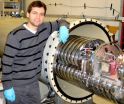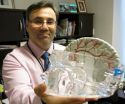(Press-News.org) Currently, the main factors thought to be associated with outcomes after the repair of peripheral nerve injuries are the age of the patient, mechanism of injury, nerve injured, injury location, defect length, repair time, repair method, operation technique, and repair materials. However, despite numerous studies of outcomes after the repair of peripheral nerve injuries, there is no agreement regarding the independent predictors of a good prognosis, and the dose-effect relationship of the predictors has not been quantified. A study by Dr. Bo He and co-workers from the First Affiliated Hospital of Sun Yat-sen University in China showed that predictors of outcome after the repair of peripheral nerve injuries include age, gender, repair time, repair materials, nerve injured, defect length, and duration of follow-up, and the nerve injured is the main factor affecting the rate of good to excellent recovery. The impact of these predictors on the outcome varies. Functional recovery of peripheral nerve injuries is multifaceted, and different factors may affect outcome in different patients. This study has been reported in the Neural Regeneration Research.
INFORMATION:
Article: " Factors predicting sensory and motor recovery after the repair of upper limb peripheral nerve injuries," by Bo He, Zhaowei Zhu, Qingtang Zhu, Xiang Zhou, Canbin Zheng, Pengliang Li, Shuang Zhu, Xiaolin Liu, Jiakai Zhu (Department of Microsurgery and Orthopedic Trauma, the First Affliated Hospital of Sun Yat-sen University, Guangzhou, Guangdong Province, China)
He B, Zhu ZW, Zhu QT, Zhou X, Zheng CB, Li PL, Zhu S, Liu XL, Zhu JK. Factors predicting sensory and motor recovery after the repair of upper limb peripheral nerve injuries. Neural Regen Res. 2014;9(6):661-672
Contact: Meng Zhao
eic@nrren.org
86-138-049-98773
Neural Regeneration Research
http://www.nrronline.org/
Factors predicting functional recovery of the upper limb after peripheral nerve injuries
2014-08-27
ELSE PRESS RELEASES FROM THIS DATE:
Gifts that generate gratitude keep customers loyal
2014-08-27
Despite major retailers investing tens of millions of dollars a year into loyalty programs, they are a dying breed, with customers struggling to see the benefits of signing up, according to QUT research.
But benefits that stimulate gratitude in customers have the power to strengthen the seller-customer relationship and ensure loyalty, researchers Dr Syed Hasan, Professor Ian Lings, Associate Professor Larry Neale and Dr Gary Mortimer, from QUT's School of Advertising, Marketing and Public Relations, found.
Lead researcher Dr Hasan, a Postdoctoral Research Fellow, said ...
Piglet weaning age no bar to litter frequency
2014-08-27
University of Adelaide research has shown that piglets can be weaned later with no negative effects on sow birthing frequency.
The outcome of the study at the University's Roseworthy campus, published in the journal Animal Reproduction Science, is an important finding for pig producers. It allows improvements in piglet health and welfare without loss of production.
"Sows don't usually start their oestrous cycles again during lactation, only coming on heat after their piglets have been weaned," says Ms Alice Weaver, PhD candidate with the School of Animal and Veterinary ...
Measurement at Big Bang conditions confirms lithium problem
2014-08-27
The field of astrophysics has a stubborn problem and it's called lithium. The quantities of lithium predicted to have resulted from the Big Bang are not actually present in stars. But the calculations are correct – a fact which has now been confirmed for the first time in experiments conducted at the underground laboratory in the Gran Sasso mountain in Italy. As part of an international team, researchers from the Helmholtz-Zentrum Dresden-Rossendorf (HZDR) studied how much lithium forms under Big Bang conditions. The results were published in "Physical Review Letters".
Lithium, ...
Gamblers are greedy bird-brains, University of Warwick research finds
2014-08-27
Gamblers are greedy bird-brains, University of Warwick research finds
Gamblers show the same tendencies as pigeons when they make risky decisions, new research has shown.
Researchers, led by Dr Elliot Ludvig of the University of Warwick's Department of Psychology, conducted tests that found that both human gamblers and pigeons were 35% more likely to gamble for high-value than low-value rewards.
Published in Biology Letters, the researchers argue that the test results show the important role that memories of previous biggest wins and losses play when we make risky ...
The thunder god vine, assisted by nanotechnology, could shake up future cancer treatment
2014-08-27
Hepatocellular carcinoma (HCC) is the second leading cause of cancer-associated death worldwide. These regrettably poor prognoses are due to the difficulty in treating this cancer using conventional chemotherapeutic drugs such as doxorubicin, epirubicin, cisplatin, 5-fluorouracil, etoposide or combinations therein. This may be attributed to that the conventional medicines are not able to reach in a sufficient concentration in the liver tumor cells at levels that are not harmful to the rest of the body. Considering the large percentage of patients that are deemed ineligible ...
DTU researchers film protein quake for the first time
2014-08-27
One of nature's mysteries is how plants survive impact by the huge amounts of energy contained in the sun's rays, while using this energy for photosynthesis. The hypothesis is that the light-absorbing proteins in the plant's blades quickly dissipate the energy throughout the entire protein molecule through so-called protein quakes. Researchers at DTU Physics have now managed to successfully 'film' this process.
Both plants, algae and bacteria contain light-absorbing proteins which play a role in photosynthesis and thus how the organisms produce energy. However, it has ...
A prescription for better stroke care
2014-08-27
TORONTO, Aug. 27, 2014 – Stroke patients are 70 per cent more likely to continue taking their stroke prevention medications one year later if they have a prescription in hand when discharged – according to researchers at St. Michael's Hospital and the Institute for Clinical Evaluative Sciences (ICES).
Using data from 11 stroke centres, researchers determined how many Ontarians were taking their medications one week, one year and two years after having a stroke. The results reveal the importance of simple interventions, such as giving a prescription to a patient before ...
The roots of human altruism
2014-08-27
VIDEO:
Sakis play the group service game.
Click here for more information.
Scientists have long been searching for the factor that determines why humans often behave so selflessly. It was known that humans share this tendency with species of small Latin American primates of the family Callitrichidae (tamarins and marmosets), leading some to suggest that cooperative care for the young, which is ubiquitous in this family, was responsible for spontaneous helping behavior. But it ...
Fighting prostate cancer with a tomato-rich diet
2014-08-27
Men who eat over 10 portions a week of tomatoes have an 18 per cent lower risk of developing prostate cancer, new research suggests.
With 35,000 new cases every year in the UK, and around 10,000 deaths, prostate cancer is the second most common cancer in men worldwide.
Rates are higher in developed countries, which some experts believe is linked to a Westernised diet and lifestyle.
To assess if following dietary and lifestyle recommendations reduces risk of prostate cancer, researchers at the Universities of Bristol, Cambridge and Oxford looked at the diets and lifestyle ...
Leading scientists call for a stop to non-essential use of fluorochemicals
2014-08-27
Fluorochemicals are synthetically produced chemicals, which repel water and oil and are persistent towards aggressive physical and chemical conditions in industrial processing. These characteristics have made the fluorochemicals useful in numerous processes and products, such as coatings for food paper and board.
The problem with fluorochemicals is that they are difficult to break down and accumulate in both humans and the environment. Some fluorochemicals have known correlations with harmful health effects, such as cancer, increased cholesterol and a weaker immune system ...





